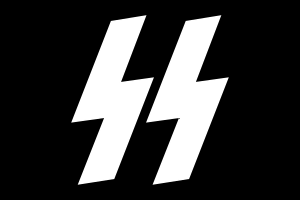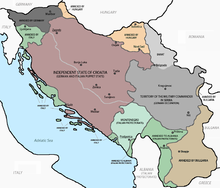Einsatzgruppe Serbia

Einsatzgruppe Serbia (EG Serbia), initially named Einsatzgruppe Yugoslavia (EG Yugoslavia), was a German Schutzstaffel (SS) grouping in the German-occupied territory of Serbia during World War II. Directly responsible to the Reich Security Main Office (German: Reichssicherheitshauptamt, RSHA) in Berlin, EG Serbia consisted of representatives of the various offices (German: Ämter) of the RSHA, particularly Amt IV – the Gestapo (Secret State Police), Amt V – the Kriminalpolizei (Criminal Police, or Kripo), and Amt VI – the Ausland-Sicherheitsdienst (Foreign Intelligence Service, or Ausland-SD). It also controlled the 64th Reserve Police Battalion of the Ordnungspolizei (Order Police, Orpo).[1] While formally responsible to the Military Commander in Serbia via the head of the administrative branch of the military headquarters of the occupied territory, the chief of EG Serbia reported directly to his superiors in Berlin.[2]
Background
Pre-war activities in Yugoslavia
In 1936, the chief of the Belgrade General Police,
In early January 1938, SS-Sturmbannführer (SS-Major) Hans Helm was appointed as a police attaché to the German diplomatic mission in Belgrade. Helm was a protege of the senior Gestapo official, Heinrich Müller, and his appointment to the position was encouraged by Jovanović and Aćimović, whom he had met when they visited Berlin. The German ambassador, Viktor von Heeren, was a former member of the diplomatic corps of the pre-Nazi Weimar Republic, and was wary of Helm and his role, and concerned about what impact the Gestapo official would have on Germany's relationship with the Stojadinović government. In December 1938, Aćimović was appointed as Minister of the Interior in the Stojadinović cabinet, but in early February of the following year, Stojadinović fell from power, and Aćimović also lost his portfolio. At the same time, Jovanović was transferred to an advisory role in the Ministry of the Interior. However, both men maintained their contact with Helm, with Jovanović allegedly permitting a secret German Abwehr (military intelligence) radio to be installed in his home. Helm maintained contact with several Germanophile officials within the Belgrade City Administration, including a White émigré Russian, Nikolaj Gubarev, an agent with the anti-communist Section IV of the Belgrade General Police. Helm cultivated Gubarev as an informant, part of an intelligence network he established throughout the country to collect political and military information, including information about British and French intelligence services operating in Yugoslavia. Helm's connection to Gubarev was known by the intelligence staff of the Supreme Command of the Royal Yugoslav Army, and as a result, in late 1939, Gubarev was transferred away from Belgrade. In addition to his intelligence work, Helm also collected commercial information, helping a German company obtain a concession to explore for oil in Yugoslavia ahead of British interests.[5] On 27 September 1939, the Gestapo and its parent organisation, the Sicherheitspolizei (Security Police, or SiPo), was placed under the umbrella of the new Reich Security Main Office (German: Reichssicherheitshauptamt, RSHA), now commanded by Heydrich, and the Gestapo became Amt (Office) IV of the RSHA, with Müller as its chief.[6][7]
Helm was under strict instructions not to deal with any people or organisations that were in opposition to the Yugoslav government. This responsibility fell to SS-
The Tripartite Pact and the coup d'état
Following the 1938
Establishment

Immediately following the coup, Heydrich summoned SS-Sturmbannführer Walter Schellenberg, the acting head of the Ausland-SD, and ordered him to compile a list of all Yugoslavs who were opposed to Nazi Germany, so they could be arrested during and after the pending invasion. This list was assembled hastily and contained a number of errors, but quickly came to comprise over 4,000 names. Heydrich then appointed SS-Standartenführer (SS-Colonel) Wilhelm Fuchs to lead Einsatzgruppe Yugoslavia (EG Yugoslavia), consisting of police and security detachments, which would be responsible for arresting those on the list. Fuchs had been the head of a SD detachment in occupied Poland. On 1 April, Fuchs went to Vienna, where he gathered about 60 SD and Gestapo officials, including experts in Yugoslavian affairs such as Helm and SS-Sturmbannführer Wilhelm Beissner, who was head of the Yugoslav section of the Ausland-SD office in Berlin. When the German-led Axis invasion of Yugoslavia commenced on 6 April, Fuchs and the main body of EG Yugoslavia were in Graz with the German 2nd Army, and a smaller Einsatzkommando (EK) led by SS-Sturmbannführer Jonak was with German troops preparing to invade Yugoslavia from Romania. On 8 April, Fuchs and his men were in Maribor, and commenced arresting people on the list. However, the rapid success of the invasion meant that by 13 April, he was in Zagreb, so he quickly formed a second EK under Beissner to operate in the newly created Axis puppet state, the Independent State of Croatia (Croatian: Nezavisna Država Hrvatska, NDH).[18]

German forces entered Belgrade on 12 April, two days later, Jonak and his EK had arrived, where they were met by Kraus, who had weathered the
The remaining territory, which consisted of
Operations
Heydrich returned to Berlin on the same day, and EG Yugoslavia immediately got to work, establishing EK Belgrade in the district prison on King Alexander I Street, and sending SS-Sonderkommandos (ad hoc task forces, or SS-SKs) into the interior of the occupied territory on various tasks. One of these SS-SKs, commanded by SS-Sturmbannführer Karl Hintze, located the
As soon as the invasion was over, Kraus became aware that former Yugoslav Prime Minister Dragiša Cvetković was seeking to return to power under German authority. Based on his work in Yugoslavia before the invasion, Kraus wrote a report recommending against this course of action.[28]
Footnotes
- ^ Browning 2014, p. 334.
- ^ Tomasevich 2001, p. 78.
- ^ a b Odić & Komarica 1977, p. 25.
- ^ Begović 1989a, p. 46.
- ^ Odić & Komarica 1977, pp. 24–29.
- ^ Broszat 1981, p. 270.
- ^ Höhne 2001, pp. 256–257.
- ^ a b Odić & Komarica 1977, pp. 29–30.
- ^ Odić & Komarica 1977, pp. 33–34.
- ^ Odić & Komarica 1977, pp. 30–50.
- ^ Odić & Komarica 1977, pp. 50–55.
- ^ Odić & Komarica 1977, pp. 57–63.
- ^ a b Roberts 1973, pp. 6–7.
- ^ Pavlowitch 2007, p. 8.
- ^ Roberts 1973, p. 12.
- ^ Pavlowitch 2007, pp. 10–13.
- ^ Roberts 1973, p. 15.
- ^ Odić & Komarica 1977, pp. 77–79.
- ^ Odić & Komarica 1977, pp. 79–80.
- ^ a b Tomasevich 2001, pp. 63–64.
- ^ Tomasevich 2001, p. 83.
- ^ Kroener, Müller & Umbreit 2000, p. 94.
- ^ Odić & Komarica 1977, pp. 80–81.
- ^ Odić & Komarica 1977, pp. 81–82.
- ^ Odić & Komarica 1977, p. 84.
- ^ Odić & Komarica 1977, pp. 82–85.
- ^ Odić & Komarica 1977, pp. 85–87.
- ^ Odić & Komarica 1977, pp. 88–89.
References
- Begović, Sima (1989a). Logor Banjica 1941–1944 [Banjica camp 1941–1944] (in Serbo-Croatian). Vol. 1. Belgrade, Yugoslavia: Institut za Savremenu Istoriju. ISBN 978-0-86740-329-9.
- Begović, Sima (1989b). Logor Banjica 1941–1944 [Banjica camp 1941–1944] (in Serbo-Croatian). Vol. 2. Belgrade, Yugoslavia: Institut za Savremenu Istoriju. ISBN 978-0-86740-329-9.
- Broszat, Martin (1981). The Hitler State: The Foundation and Development of the Internal Structure of the Third Reich. Harlow, England: Longmans. ISBN 978-0582489974.
- Browning, Christopher (2014). The Origins Of The Final Solution. London, England: Cornerstone Digital. ISBN 978-1-4481-6586-5.
- ISBN 978-0-14139-012-3.
- Kroener, Bernard R.; Müller, Rolf-Dieter; Umbreit, Hans, eds. (2000). Germany and the Second World War, Volume 5: Organization and Mobilization of the German Sphere of Power. Part I. Wartime Administration, Economy, and Manpower Resources 1939-1941. Vol. 5. New York, New York: Oxford University Press. ISBN 978-0-19-822887-5.
- Odić, Slavko; Komarica, Slavko (1977). Noć i magla: Gestapo u Jugoslaviji [Night and Fog: The Gestapo in Yugoslavia] (in Serbo-Croatian). Zagreb, Yugoslavia: Centar za informacije i publicitet. OCLC 440780197.
- ISBN 978-1-85065-895-5.
- ISBN 978-0-8223-0773-0.
- ISBN 978-0-8047-3615-2.
